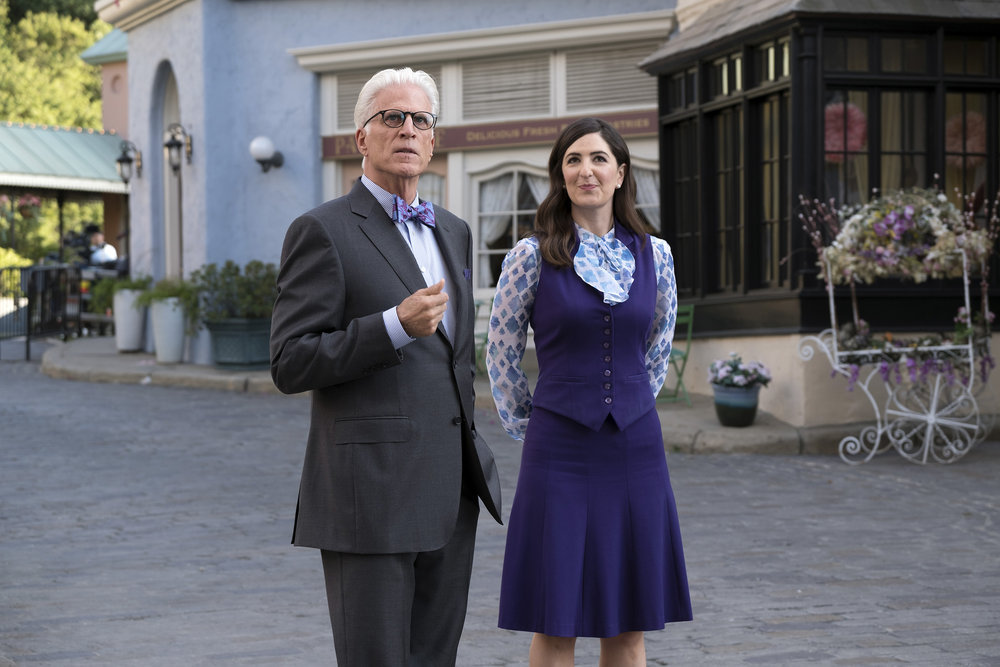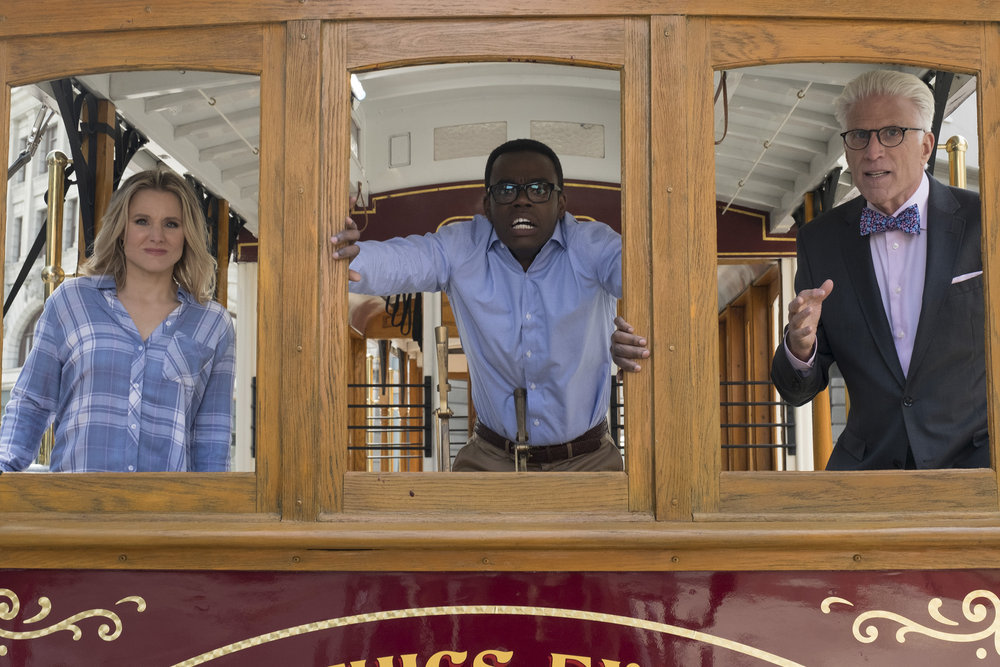The Good Place dramatized a classic philosophy case study last week in “The Trolley Problem.” The episode used the hypothetical scenario—in which one is asked to consider whether it’s more ethical to accidentally kill five people or purposely kill one—as a jumping-off point for hijinks. But creator Mike Schur’s NBC sitcom is a comedic marvel not just because it’s aping intro-level college courses; it’s also a weekly dose of brilliant silliness, expert performances, and copious warmth.
When it premiered last year, The Good Place appeared to be about one woman, Eleanor Shellstrop (Kristen Bell), who mistakenly got sent to its universe’s version of heaven despite having been a generally shitty person in her life. But then came the finale’s revelation: The good place was actually the bad place. Eleanor, the self-righteous socialite Tahani (Jameela Jamil), the nervous academic Chidi (William Jackson Harper), and the Florida idiot Jason (Manny Jacinto) were all supposed to be making each other unhappy—thanks to a devious but ultimately flawed plan hatched up by demon-type Michael (Ted Danson), who believed he could do one better than the usual fire and brimstone torture.
Videos by VICE
With that revelation, the series had to reinvent itself by necessity, but Schur and his team of ridiculously talented writers did that by doubling down on the original concept. At the end of the second episode of the new season, it became clear that The Good Place isn’t a show about one jerk trying to transform herself, but all of the protagonists working to live more consciously and kindly. That includes Michael, who needed to team up with his victims after his staff began to doubt his leadership.
“We conceived Michael this year as being the director of an independent film that has a shoestring budget that the whole crew is non-union guys that he just picked up from somewhere and everything’s going wrong and he’s just desperately trying to hold the production together,” Schur, best known for Parks and Recreation, explained. “That led to a natural thing where it’s like, well, at some point they’re going to revolt.”
Schur spoke to me last week about teaching a hell-person to be good, living in what seems like the actual version of the bad place, and the potential Westworld crossover that probably won’t be.
In “The Trolley Problem,” I was struck by the idea that there’s something depressing in that this person who’s an arbiter of fate has no ethical compass. What do you want to explore with Michael’s journey this year?
We’re trying to answer the question, “Is it possible to rehabilitate someone who is purely evil?” In order for us to have the answer to that question be “yes,” we had to design a kind of evil that wasn’t a person who was born on Earth and had a screw loose—or a sociopath, or someone who had a traumatic incident that caused him to have psychological damage. He’s part of a system that thinks of itself as righteous: There are good people on Earth that go to one place, and there are bad people on Earth that go to another.
We had to keep in our brains that Michael doesn’t think that he is doing anything wrong when he’s punishing people—he’s fulfilling his purpose. Now, we’re introducing to that person that there’s an ethical underpinning to the decisions that people make and how you weigh good against bad. That’s not an easy thing for him to get, or for humans to understand. I don’t think I understand it very well.

When the finale aired, Splitsider published a piece titled “The Good Place‘s Optimism Is a Salve for Despair in the Trump Era.” Has the state of the world influenced the second season at all?
Honestly, I don’t know. I would say not consciously. The show was conceived of when President Obama was in office, and when I assumed—like most people—that the weird, sociopathic, cruel monster who is currently president would not be. No part of the original design had anything to do with Trump, or anyone specifically. It was about a question that I’ve been asking myself for most of my adult life: What does it mean to be good? What does it mean to be bad? How do you live your life ethically? What’s the kind of most important aspect of living an ethical life?
It’s been very interesting to write a show that’s explicitly about ethics as the word appears on the front page of most major newspapers daily. None of the characters on our show are politicians, and for good reason—that would have been too on the nose, right? But Tahani’s flaw is that she did good things for bad reasons: selfishness, a search for fame, and an attempt to fill a deep hole in her heart that was caused by a lack of parental love and support. That’s so Trumpian, in some ways. It’s interesting when you ask questions about how people behave, and then you see those things being writ large in the nation in which you currently exist in. It’s fascinating, and I would say it’s fun—except that it’s also existentially terrifying on a daily basis.
Did you want to do a trolley-problem episode from the beginning?
I’ve read a lot of books about ethics and moral philosophy, which I understand on what I’d describe as Wikipedia-entry level. Philosophers make up games and thought problems, and I’m always so grateful when they do because I’m like, “Now I can understand it.” I wanted to do one episode this year that was like a deep dive with one of those thought experiments, because I find those to be the most fun. The trolley problem is probably the most famous one—it’s oft-discussed, but also it’s very fun because there are a lot of variations on it. The whole point of the episode is that Michael lashes out by turning the thought experiment into a real experiment, and the trolley problem is the perfect thing for that.
The fact that Janet’s gaining some human emotions is messing with everything as well. What are your intentions with her this season?
When we knew that we wanted to do this Groundhog Day thing where Michael reboots everybody over and over and over again, it was very important we make it clear that they don’t remember anything. Very often there will be a little shadow that hangs over people when their minds are wiped clean. I wanted to make it very clear that the four humans don’t remember a single thing. But there are also fun stories to be told when someone does have a shadow memory, so the being for whom that made the most sense was Janet.
It’s funny, because we did all this stuff in the first season with Janet before Westworld was on, and when we were watching Westworld it was like, “Oh boy, there’s a weird overlap here.” It led to us having some fun in the writer’s room imagining a Westworld–Good Place crossover episode—which is probably not possible. There’s a story with Janet this year that involves what happens to whatever she is when that shadow memory comes back to haunt her.
The show started off with this idea of soulmates, and now you’re getting into situations where characters are getting together in a romantic way. How did you think about threading that through?
We’re so deep into the history of TV now, where there have been so many versions of different kinds of relationships that the only thing you have left is surprise. There’s nothing wrong with classic romance and good old-fashioned slow-building emotion, but these things work best when you don’t follow a prescribed pattern.
The great thing about The Office‘s relationship was how slowly it built—Greg Daniels used to describe it as a spiderweb shimmering in the light, where if you just shift one inch to the left it takes on a different view. The lesson I took from that was every relationship needs to be specific about why these two people care about each other—how they express their feelings for each other, and what is truly happening in their brains, hearts, and souls at every given moment. It’s a pain in the ass. In our case, we have four weird people in weird relationships in a weird situation, so we tried to be truthful to the strange situations that the four of them find themselves in.
Follow Esther Zuckerman on Twitter.




